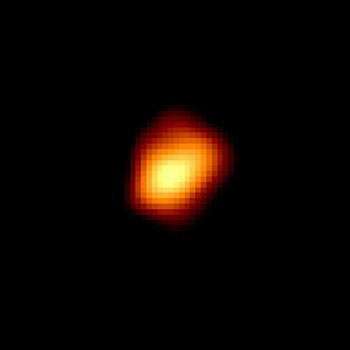Mira, as seen by the Hubble Space Telescope.
There are many stars which show a degree of variability. Some are eclipsing binaries (see the Star of the Month for December 2019) and others are in some way unstable, like Delta Cephei (Double Star of the Month October 2019). Red giants are a specific group of stars which show variability. Betelgeuse, the bright red giant in Orion, varies between 0.0 and 1.3, the greatest variability of any first magnitude star. However the average person would be hard pushed to notice this variation (but try by comparing it with Rigel on the other side of Orion which has a magnitude of 0.1, sometimes Betelgeuse will be the equal of Rigel and sometimes it will be dimmer). But there is a red giant in the large but dim constellation of Cetus (the sea monster, sometimes mistakenly called the whale) which varies very visibly. Omicron Ceti varies between magnitude 3.4 when it is clearly visible to the naked eye even in Havering to magnitude 9.3 when it will be practically invisible in a small telescope. But it gets even easier. Mira happens to be a double star and by chance it has an optical companion which has a magnitude of 9.7, just slightly dimmer than Mira at its minimum! Just find Mira in the sky (see below) and look at it through a telescope (4 inch or larger is best). If it is much brighter than its companion, it is near maximum and if it is more or less the same, it is at minimum (this does work, I have observed this myself). The period of Mira is 332 days so you will need to observe it for nearly a year to see the whole cycle. The next minimum is in March which is when Mira is about to set for the summer and the maximum will be when it is not visible (late June) so we are not in a good time for seeing Mira. There are two ways to locate Mira if you do not have go-to. Either find the pentagon of stars in Pisces (the “circlet”) under the square of Pegasus (in Havering you may need binoculars to do this) and go left (eastwards) until you see another pentagon of stars slightly higher. Right under this pentagon is Mira. Alternatively take the two bottom stars of Orion (Saiph and Rigel) and go right (westwards) until you see the pentagon of stars in Cetus a bit higher up and look underneath for Mira. The variability of Mira was first noted by the German amateur astronomer David Fabricus in 1596 and quite logically he assumed it was a nova (Tycho Brahe had seen the first nova in modern times in 1572) until he saw it again in 1609. It was named Mira (Latin for 'wonderful' or 'astonishing') by Johannes Hevelius in his Historiola Mirae Stellae of 1662.
